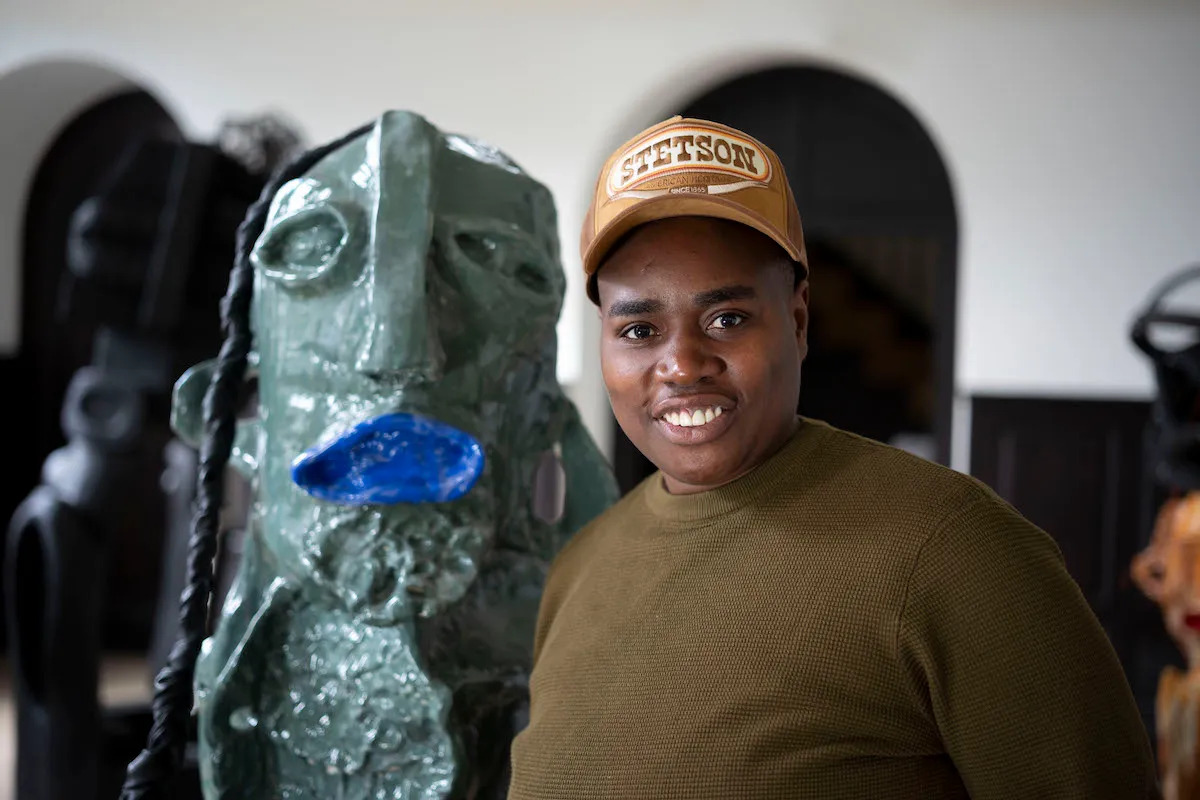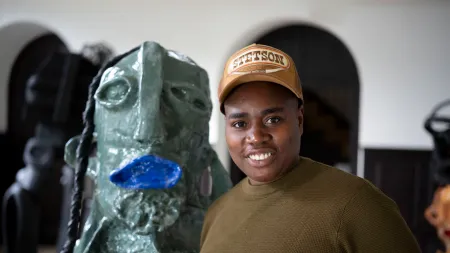
Like her imposing sculptures, Leilah Babirye is still standing. And even better, she is thriving.
In 2015, Babirye fled Uganda after she was outed by a local publication as an activist and a member of the queer community. In her home country, being queer is considered a crime and can even be punished with a life sentence in prison. (Since Babirye left, the consequences have only gotten worse. Last year, Ugandan president Yoweri Museveni signed the Anti-Homosexuality Act of 2023, which includes punishment of death sentence for those convicted of “aggravated homosexuality.”)
Babirye ended up in New York, and has been based there for the nine years since, working as an artist as well as an activist. During a recent interview with ARTnews, it was clear that she had no regrets about her identity—and that she wanted her artworks to similarly exhibit a sense of pride.
“I want my sculptures to command attention,” she said. “I give them hairstyles and adornments, inspired by the queer community, so yes, it gives the feeling of: We’re here, and we’re not going anywhere.”
In the Luganda language, one of the most widely spoken tongues of Babirye’s homeland, the Ugandan queer community is referred to as “abasiyazi,” which translates to “sugarcane husk,” a reference to the fact that the community’s members are thought of as discarded parts or rubbish. In Babirye’s hands, however, trash from the streets, junkyards, bike shops and other places takes on a new meaning, becoming material used in artworks that explore sexuality, identity and human rights. The negative connotations that follow the word “rubbish” are turned positive.
“Once I realized that you can use found objects and trash as art materials, I realized that I could let go of the negative meaning of the word. No one is rubbish,” she stated. “The process was very positive for me. I used to make work from pain, but now, I make it from joy.”
These artworks—acrylic paint on paper drawings that represent queer people, ceramics made of clay and sculptures made from wood she carves, welds, burns, burnishes, and adorns with found items—have caught on with the art world. Babirye’s artworks can now be seen at the Venice Biennale, where they line one part of a garden that acts as a venue in Adriano Pedrosa’s main show, and at the Yorkshire Sculpture Park in Wakefield, England, where she is having a solo exhibition. On Saturday, she will open her first-ever US solo show at the de Young Museum in San Francisco where she is showing a dozen sculptures, some of which are new.

For some, Babirye’s art is so effective because it bridges so many timelines and formal techniques. “I think Leilah’s work resonates with many people because it taps into historical and contemporary art as well as social issues across cultures and geographic boundaries,” said Sam Gordon, cofounder of Gordon Robichaux, her New York gallery. “Her work is deeply personal, confident, commanding and political, and this is bound up with the material and form.”
The Yorkshire Sculpture Park show, the result of a 2023 residency there, situates a series of larger-than-life works within an 18th-century chapel. Titled “Obumu (Unity),” it features seven wooden sculptures that were carved out of a 200-year-old fallen beech tree from the park and five large ceramic portrait sculptures made of clay all adorned with found objects, building on her practice of giving life to discarded materials, which tell “a story of joy, transformation, and, of course, unity,” she said. The latter, which she calls “an important theme” in her work, is about bringing together queer communities and showing the power of collaboration, not just when it comes to making her art but within life more broadly.
The artist said she was fascinated by the experience of working in the environment at the sculpture park because of its history. The park hosts works by British modernists Barbara Hepworth and Henry Moore, whose sculptures are sleek and sinuous. By contrast, Babirye’s are rough-hewn, a quality the artist embraces. But even so, Babirye said she’d looked to Hepworth and Moore for inspiration since college, and it becomes clear that her works does share a connection to theirs.
“It’s as though Leilah has absorbed centuries of global sculpture-making, and she has made an innate ability to transform trees and clay into entities that have never existed, that have individual personalities yet speak of a universal earth,” Clare Lilley, director of the Yorkshire Sculpture Park, told ARTnews.
Contemporary artists, from Yinka Shonibare to Ai Weiwei, have regularly shown their art here, but Lilley praised Babirye’s show as being unique among because of its “abundant personalities who so loudly sing together in the space. Leilah is at the heart of what is important and worthwhile in art.”

Lilley first became aware of Babirye’s practice when she saw her “raw and uncompromising” sculptural double portrait, Tuli Mukwano (2018), which was shown at Socrates Sculpture Park in Queens, New York. The two figures in that work—pressed cheek to cheek, with crown-like attachments made of used cans—were carved from a pine log using a chainsaw. The sculpture’s title translates from Swahili to “We are in love.”
Three years later, Lilley was awed by a show at London’s Stephen Friedman Gallery, which represents Babirye alongside New York’s Gordon Robichaux. “ It was strong and visceral and also loving and celebratory, most especially of women and Uganda’s LGBTQ+ community,” she said. “Her work caused me to cry.”
Babirye was born in 1985 in Kampala, Uganda. In high school, she and her mates took art course because they thought it’d be “an easy class.” There, she studied basics like still life drawing, which didn’t exactly have strict guidelines.
She didn’t become serious about art until 2007, when she was a student at Makerere University, where her professors taught wood carving and ceramics. “The ceramics program was focused on wheel throwing, but I was more excited about hand building because of the endless possibilities in what I could create,” she said.
In 2011, David Kato, a Ugandan LGBT rights activist, was murdered. Babirye said that was “an important event that sparked my activism.” She noticed that during the ensuing protests and Kato’s funeral, some demonstrators decided to cover their faces with masks to protect their identities. “This inspired me to create masks during my senior dissertation,” she said.
Since the early 2010s, Babirye has been including found objects including newspapers, aluminum cans, trash, and items she found on the streets in her work. The intention, she said was to “give honor to discarded materials and show that there is beauty in everything.” She went on, “I still get materials from the street, junkyards, bike shops, and more. I make them into something beautiful and important.”

Within the US, her work was almost immediately recognized as such. In 2015, the year she was forced to leave her home country, she participated in the Fire Island Artist Residency in New York, billed as the first LGBTQ artist residency in the world. Three years later, she was granted asylum in the United States and had her first solo show at Gordon Robichaux.
Even while working in New York, she continues to ensure that her work retains an African context. She has drawn influence from West African masks, which she finds “interesting because of the facial expressions and emotions that they communicate. For the Yorkshire Sculpture Park show, she created a mask titled Nakakumba, based on similar ones from the Kuchu Ngo (Leopard) clan. Babirye’s rendition is adorned with hammered metal, nails, bicycle parts and braided tires. “I draw inspiration from drag queens and fashion in the LGBTQ+ community when I add these adornments, which I think of as jewelery, accessories and hair,” she shared.
Babirye has also continued to create painted works on paper that she’s called “Identity Cards,” a reference to Ugandan ID cards. They’re inspired by people she knows, and also feature imagined characters that represent queer Ugandans.
“I like there to be some ambiguity when it comes to their gender. I draw fun hairstyles, jewelery and clothes similar to how I adorn my sculptures,” she said, adding, “I want people to feel empowered to embrace themselves when they see my work.”
Why Are Robert Mapplethorpe’s Provocative Images Seemingly Everywhere These Days?
Despite Economic Uncertainty, Gallery Weekend Beijing Left Dealers Feeling Optimistic

Lewis Hamilton: The Spanish Grand Prix Usually Tells You How Good Your Car Is

Celebrities Meeting the British Royal Family: From John Travolta Dancing With Princess Diana to Taylor Swift Singing With Prince William and More

Researchers made a battery you can eat that will power an edible robot

NBA, NFL Pros Back Dartmouth Labor Push as AFL-CIO Files for SEIU


